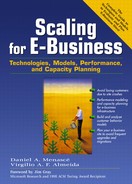2.4. The Customer Behavior Model Graph (CBMG)
A Customer Behavior Model Graph (CBMG) has n states, where state 1 is always the Entry state and state n is always the Exit state. The actual number of states and the type of states of a CBMG vary among e-commerce sites. For example, online trading sites may have other types of states such as Obtain Quote, Trade Stock, Trade Mutual Fund, View Chart (of stock value variation), Access Portfolio, and Get Press Releases (on a company).
A CBMG is a characterization of the navigational pattern of a group of customers, as viewed from the server side. This means that a transition from state i to state j is said to occur when the request to go to state j arrives at the server. In Fig. 2.4, the transition from state Search to Select is said to occur when the e-commerce server receives a request to display additional information about one of the books that resulted from a previous search. User requests that are resolved at the browser cache or at a proxy server cache are not seen by the e-commerce server and therefore are not reflected in the CBMG. This is not a problem when the purpose of the workload characterization is for server sizing and capacity planning. In these cases, it is important to capture the load imposed on the server resources by the various requests submitted by a customer. It should also be noted that, in the case of e-commerce, many pages that are intrinsically static are generated dynamically and therefore are not cached because they contain advertisement. Zaiane et al discuss the problem of relying solely on server side information in the context of using data mining and online analytic processing techniques (OLAP) on HTTP logs [9]. The authors conclude that although server side information is not 100% complete, much useful information can be discovered from it.
So, a CBMG can be more formally characterized by a set of states, a set of transitions between states, and by an n×n matrix, P = [pi,j], of transition probabilities between the n states of the CBMG. A similar matrix exists in which Online Analytical Processing (OLAP) and Data Mining techniques are used to analyze Web logs [9]. Table 2.1 shows the transition probability matrix P for the CBMG of Fig. 2.4. Note that the elements of the first column and last row of the matrix P for any CBMG are all zeroes since, by definition, there are no transitions back to the Entry state from any state nor any transitions out of the Exit state.
A CBMG has two aspects: a static and a dynamic one. The static aspect reflects the structure of the e-commerce site and does not depend on the way users access the site. The static aspect of the CBMG is composed of the set of states and the set of possible transitions between these states. The matrix of transition probabilities, P, is part of the dynamic aspect of the CBMG. Figure 2.2 is the static aspect of the CBMG of Fig. 2.4. All groups of customers share the same static aspect of the CBMG since this is a characteristic of the functions provided by the e-commerce site, of the organization of the pages, and of the ways of invoking the various functions from the several pages.
| y | h | b | s | 1 | p | r | a | t | x | |
|---|---|---|---|---|---|---|---|---|---|---|
| Entry (y) | 0.00 | 0.70 | 0.15 | 0.15 | 0.00 | 0.00 | 0.00 | 0.00 | 0.00 | 0.00 |
| Home (h) | 0.00 | 0.00 | 0.30 | 0.30 | 0.10 | 0.00 | 0.10 | 0.00 | 0.00 | 0.20 |
| Browse (b) | 0.00 | 0.20 | 0.25 | 0.25 | 0.00 | 0.00 | 0.00 | 0.00 | 0.20 | 0.10 |
| Search (s) | 0.00 | 0.20 | 0.25 | 0.25 | 0.00 | 0.00 | 0.00 | 0.00 | 0.20 | 0.10 |
| Login (1) | 0.00 | 0.60 | 0.30 | 0.00 | 0.00 | 0.00 | 0.00 | 0.00 | 0.00 | 0.10 |
| Pay (p) | 0.00 | 0.00 | 0.00 | 0.00 | 0.00 | 0.00 | 0.00 | 0.00 | 0.00 | 1.00 |
| Register (r) | 0.00 | 0.50 | 0.00 | 0.00 | 0.40 | 0.00 | 0.00 | 0.00 | 0.00 | 0.10 |
| Add to Cart (a) | 0.00 | 0.00 | 0.20 | 0.20 | 0.05 | 0.30 | 0.05 | 0.05 | 0.10 | 0.05 |
| Select (t) | 0.00 | 0.00 | 0.35 | 0.35 | 0.00 | 0.00 | 0.00 | 0.20 | 0.00 | 0.10 |
| Exit (x) | 0.00 | 0.00 | 0.00 | 0.00 | 0.00 | 0.00 | 0.00 | 0.00 | 0.00 | 0.00 |
We can now view an e-commerce site as a business that provides to its customers several Web-based functions such as Browse, Search, Select, and Pay. These functions use the IT infrastructure of the site, i.e., its processors, internal networks and routers, and storage subsystems. Different visits by the same customer or by different customers invoke these functions in different patterns as described by a CBMG (see Fig. 2.5).
Figure 2.5. E-business Site View from the User Perspective.

